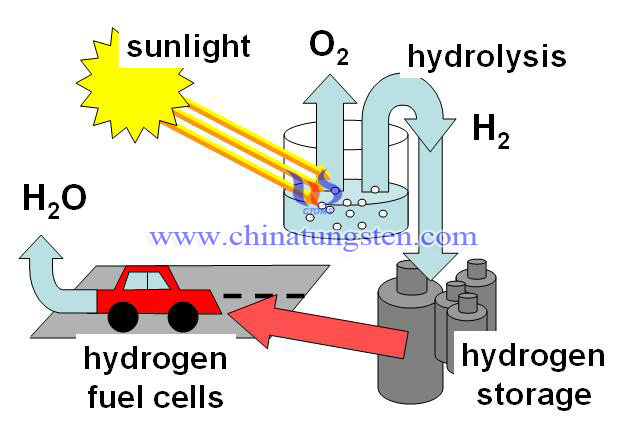A New Synthesized Photocatalyst-Tungsten Trioxide-Graphene Composite Photocatalyst
- Details
- Category: Tungsten Information
- Published on Wednesday, 08 August 2018 19:41
Although fossil fuel based energy supports the development of modern society, it brings up the global issues of global warming and climate change. Thus scientists have been seeking for a clean energy to replace the fossil fuels. The photocatalytic decomposition of water to produce hydrogen is considered as a promising way to solve those environmental issues in the future. The key to make it possible is to find a photocatalyst with required properties.
After the researchers have undergone numerous theoretical calculations and experimental verifications, what do they think may be a substance that has the property of photocatalytic decomposition of hydrogen produced by water? - When the photocatalyst's conduction band position is higher than 0eV. Under what circumstances may it have the performance of photocatalytic decomposition of aquatic oxygen? - When the catalyst valence band position is below 1.23 eV.
Then, they found that tungsten trioxide not only has visible light absorption capacity, but also its conduction band and valence band positions are around 0.7 eV (above 0 eV) and 3.4 eV (not less than 1.23 eV). Therefore, from these two values, you can also know that tungsten trioxide has only the performance of photocatalytic hydrogen production. Undoubtedly, since the use of tungsten trioxide for photodecomposition of water to produce hydrogen has become a relatively important study in the study of the photocatalytic properties of tungsten trioxide!
The band gap of tungsten trioxide is about 2.7eV, and it is generally considered that the appropriate photocatalyst band gap is 1.8eV. You may ask: How is this appropriate value obtained? - It is obtained by considering the existence of overpotential during the hydrogen production (oxygen) process. Therefore, is it appropriate to use tungsten trioxide to be applied in photocatalytic decomposition of water?
Some researchers have used ultrasonic method to synthesize tungsten trioxide-graphene composite photocatalyst, and then carried out photocatalytic oxygen production performance test. They have found that, at the same method and conditions, the synthesized oxygen photocatalyst has higher oxygen production performance than thet of tungsten trioxide, graphene, and simply mixed samples. The researchers also found that the chemical bond between tungsten trioxide-graphene reduces the interfacial defects of the composite product, thereby reducing the recombination probability of photogenerated carriers - mainly by comparing the graphene D and G peaks intensity ratio of Raman in the sample. In addition, graphene can sensitize tungsten trioxide, thereby expanding the light absorption range and improving light utilization efficiency, and graphene can be used as a transmission medium of photogenerated electrons, thereby improving light conversion efficiency.
Researchers may not be satisfied with this. With the deepening of research, they have expanded the application range of tungsten trioxide, and the application of photochemical batteries or Z-type reaction systems to adjust the position of the conduction band to meet the hydrogen production conditions of tungsten trioxide, and apply it in photocatalytic hydrogen production.
In addition, researchers used simple glucose hydrothermal carbonization and dialysis to prepare carbon nanodots, and added them to the aqueous solution of methanol with tungsten trioxide and NaI for photocatalytic hydrogen production. They found that after the addition of tungsten trioxide, the hydrogen production of the system increased from 4.65 μmol•g-1•h-1 to 1330 μmol•g-1•h-1, which means that the photocatalytic decomposition of hydrogen produced by tungsten trioxide is true.
- Tungsten Oxide Manufacturer & Supplier, Chinatungsten Online: www.tungsten-oxide.com
- Tungsten News & Prices of China Tungsten Industry Association: www.ctia.com.cn
- Molybdenum News & Price: news.molybdenum.com.cn
- Tel.: 86 592 5129696; Fax: 86 592 5129797; Email: sales@chinatungsten.com




 sales@chinatungsten.com
sales@chinatungsten.com